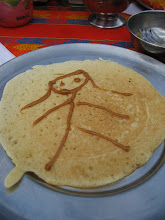|
Friday, March 14, 2008
Wednesday, June 07, 2006
Dear Reader
This is a compilation of works done for and by my students in my English 97, beginning writing and grammar course. It's been a great quarter and as one of my students wrote, "My teacher was never lacking in the area of assigning homework." So thank you to my students for all their hard work and for being guinea pigs, in a sense, in the computer lab and with these blogs. They've had to do a lot and be very flexible and I've appreciated their efforts and willingness to try and learn.
I've included in my eportfolios several pieces: a major writing assignment that I use to instruct students on how to write a process paper, a blog assignment that we all enjoyed, an example of some descriptive writing that past students have done, and finally, a writer's choice, a list of skeletons, that I've always found fun to do with students.
Thanks for taking the time to look at our collective work. It's the write attitude!
I've included in my eportfolios several pieces: a major writing assignment that I use to instruct students on how to write a process paper, a blog assignment that we all enjoyed, an example of some descriptive writing that past students have done, and finally, a writer's choice, a list of skeletons, that I've always found fun to do with students.
Thanks for taking the time to look at our collective work. It's the write attitude!
Introduction to Major Writing Assignments
Major writing assignments are papers that go through the whole writing process, from pre-writing to drafting to getting response to re-writing to editing to evaluation. It takes an idea and follows it through to being a polished, finished piece of writing. One of the MWAs that I've continued to enjoy and really learn from is the process paper. I like the clarity and the challenge of writing concisely with a strong sense of purpose and audience.
Major Writing Assignments: The Process Paper
English 97
Major Writing Assignment #3
The Process Essay
Your final major writing assignment will be a process essay which either explains how or why something works the way it does (like why leaves turn yellow and red in the fall) or gives directions to someone on how to do something (like how to have a garage sale.)
Think of one process that you know a fair deal about since this is not really supposed to be a research paper. Remember that this is a 2-3 page paper so pick your topic accordingly—how to clean out a locker would be too simple; how to build an engine might be a bit complex. Please do NOT do recipes. Start with brainstorming the major steps of your process, making sure to list each step. Carefully think about what your audience may or may not know, giving hints, tips, or advice and explanations of why something is important or what not to do as needed. If you are explaining a fairly technical procedure, make sure you give explanations of what certain things/terminologies are (i.e. a fairway, a jump, a carburetor, etc.) Consider your purpose as while—do you want to merely inform or also to entertain and/or persuade?
Finally, when you are ready to write, make sure to follow the structure of an essay. Start with an interesting lead-in (examples on p.166) and make sure to have a thesis that has some tension and includes the main point of your essay. Use clear topic sentences at the beginning of each paragraph, including transitions to guide your reader and achieve coherence. Assume your audience/reader has some knowledge of your process but is no expert so make sure your have adequate supporting details to make the process clear to a beginner.
All drafts should be double-spaced, preferably typed. Final drafts MUST be typed, double-spaced, 12 point font, standard Word margins, and approximately 2-3 pages and have your name, class, and date on the top of the page. In order to get full credit for the peer response time, you need to be present on the day the drafts are exchanged with enough copies of your draft for members of your group. You also need to be present the day the peer group meets, having read and responded to all the other members’ papers. Remember, the groups only work as well as those who participate in it.
Deadlines
First draft due
Peer response
Final draft due
Note: no 2nd draft will be required, but you should proofread your own drafts carefully!
Major Writing Assignment #3
The Process Essay
Your final major writing assignment will be a process essay which either explains how or why something works the way it does (like why leaves turn yellow and red in the fall) or gives directions to someone on how to do something (like how to have a garage sale.)
Think of one process that you know a fair deal about since this is not really supposed to be a research paper. Remember that this is a 2-3 page paper so pick your topic accordingly—how to clean out a locker would be too simple; how to build an engine might be a bit complex. Please do NOT do recipes. Start with brainstorming the major steps of your process, making sure to list each step. Carefully think about what your audience may or may not know, giving hints, tips, or advice and explanations of why something is important or what not to do as needed. If you are explaining a fairly technical procedure, make sure you give explanations of what certain things/terminologies are (i.e. a fairway, a jump, a carburetor, etc.) Consider your purpose as while—do you want to merely inform or also to entertain and/or persuade?
Finally, when you are ready to write, make sure to follow the structure of an essay. Start with an interesting lead-in (examples on p.166) and make sure to have a thesis that has some tension and includes the main point of your essay. Use clear topic sentences at the beginning of each paragraph, including transitions to guide your reader and achieve coherence. Assume your audience/reader has some knowledge of your process but is no expert so make sure your have adequate supporting details to make the process clear to a beginner.
All drafts should be double-spaced, preferably typed. Final drafts MUST be typed, double-spaced, 12 point font, standard Word margins, and approximately 2-3 pages and have your name, class, and date on the top of the page. In order to get full credit for the peer response time, you need to be present on the day the drafts are exchanged with enough copies of your draft for members of your group. You also need to be present the day the peer group meets, having read and responded to all the other members’ papers. Remember, the groups only work as well as those who participate in it.
Deadlines
First draft due
Peer response
Final draft due
Note: no 2nd draft will be required, but you should proofread your own drafts carefully!
Introduction to the Blog
Having never attempted blogs with an English 97 class, the group did smashingly well and thank you being such willing test subjects. One of the blogs I enjoyed putting together and having people do the most was one that asked students to take a look at Renoir's famous painting of a couple in a garden and to write the dialogue of what happened.
Blogs: The Talk
Introduction to Specificity
Descriptive Piece: Specificity Exercise
Specificity—great examples!
Rhoda and I worked until we were completely exhausted planting new flowers, digging trees, and weeding my back yard.
My little cousin Erika was teething and howled the entire evening.
The taco salad I ordered at the Mexican restaurant was nothing but wilted lettuce, mushy tomatoes, and dried out meat.
The smell of a dead rabbit permeated throughout the hallway when Jim opened the door to his apartment.
From the window you can see the mountains, rolling fields, and beautiful pink sunset.
Mr. Jenkins lifted Tanya from the playground’s asphalt and placed a Spiderman bandage on her freshly cut knee.
Buster’s dog collar ID jingled all night from him chasing the fleas on his skin.
Rhoda and I worked until we were completely exhausted planting new flowers, digging trees, and weeding my back yard.
My little cousin Erika was teething and howled the entire evening.
The taco salad I ordered at the Mexican restaurant was nothing but wilted lettuce, mushy tomatoes, and dried out meat.
The smell of a dead rabbit permeated throughout the hallway when Jim opened the door to his apartment.
From the window you can see the mountains, rolling fields, and beautiful pink sunset.
Mr. Jenkins lifted Tanya from the playground’s asphalt and placed a Spiderman bandage on her freshly cut knee.
Buster’s dog collar ID jingled all night from him chasing the fleas on his skin.
Introduction to Writer's Choice
I chose the skeletons to be my Writer's Choice winner because each time I've used this exercise, I've been surprised and delighted by the creativity and cleverness of how each of these "bare bones" can get fleshed out. From a bus accident to a police sting behind the snack bar, skeletons have really encouraged people to think outside of the box.
Subscribe to:
Comments (Atom)


